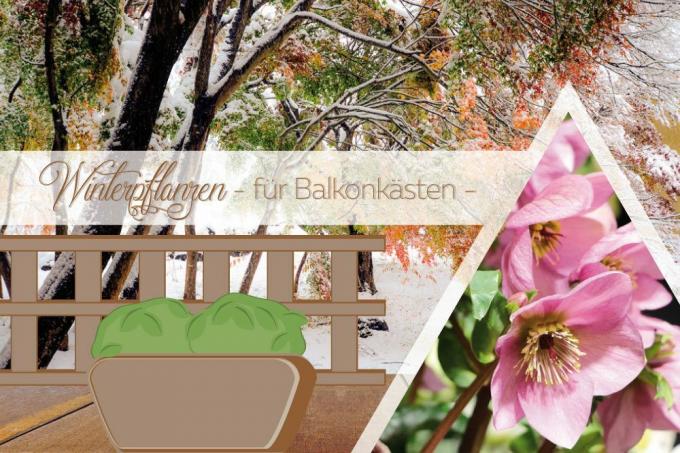
table of contents
- Winter plants
- Winter blooming balcony flowers
- Hardy grasses
- Evergreen dwarf shrubs
- Colorful winter plants
- Winter plants with colorful berries
- Nice combinations
If you love lush flowers in the balcony box in summer, you may not want to do without a little attractive greenery and a few blooming balcony flowers in winter. In this case, hardy plants are just the thing. Usually it is evergreen winter flowers that find a place on the balcony during the cold season. But there are also winter-blooming balcony flowers that set very special highlights.
Winter plants
Robust winter plants for the balcony
The cold season is no reason to forego attractive winter flowers on the balcony, because there are numerous frost-hard and even winter-blooming balcony flowers on the market. Whether evergreen, with colorful leaf decorations, blooming buds or bright red berries - you can combine most winter plants to your heart's content.
Winter blooming balcony flowers
They really do exist: flowers that bloom in winter even in our latitudes. We have put together a few particularly robust types of the most popular winter flowers for the balcony box for you.
Christmas rose (Heleborus niger)
Christmas roses are hardy, evergreen perennials that provide rare highlights in winter. If you don't want to do without blooming winter flowers in the balcony box, the Christmas rose is the perfect solution. Depending on the weather, the winter flowers, also known as snow roses, bloom as early as September. Usually, however, the winter plants do not form their white flowers until the new year.
- Flowering time: depending on the weather (September to February)
- Flower color: mostly white (rarely with a pink border or reddish flowers)
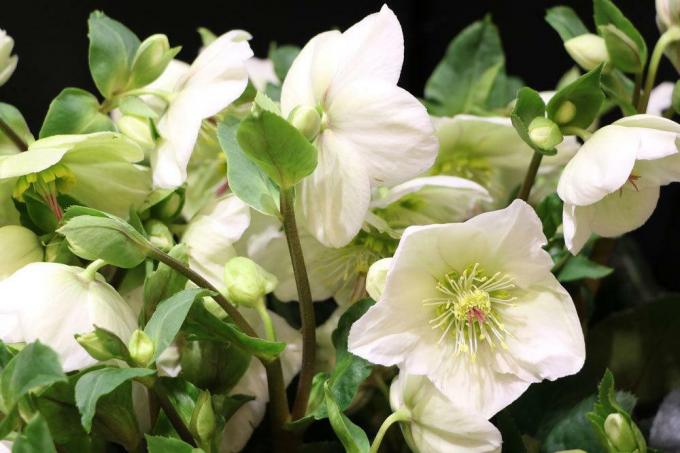
Hardy Erika (Erica darleyensis)
The heather is one of the most popular winter flowers. This is not only because you don't mind cold temperatures and frosts. This heather plant is also very floriferous. The typical, small buds of certain varieties do not open until the end of October. On the other hand, the Erika blooms in the balcony box throughout the winter.
- winter-blooming variants (late October to March)
- Flower color: in different shades of red and white, mixed colors, rarely yellowish
- Erica darleyensis: flowers very profusely
- Erica verticillata (South African heather): large, bright pink flowers in September to November

Common heather (Calluna vulgaris)
At first glance, the common heather is reminiscent of the heather. It is also one of the heather plants and forms small, mostly pink flowers. New varieties of winter flowers grow upright and cypress-like.
- belongs to the heather family (Ericaceae)
- easy to care for and evergreen
- winter-flowering varieties with pink flowers

Pansies and horned violets (viola)
Horny violets have slightly more delicate flowers than pansies. Both variants of the viola are winter blooming flowers. Depending on the variety, the winter flowers even grow hanging in a hanging basket or a balcony box.
- Flowering time: from autumn
- flowers will not form at very cool temperatures
- second bloom in early spring
- every imaginable flower color and shade, often multicolored

Hardy grasses
In addition to the winter flowers, there is a large number of hardy and evergreen ornamental grasses, with which the balcony can be put in the right light even in the cold season.
Sedges (Carex)
With over 2000 known species, sedges thrive primarily in cold and temperate climates. The sour grasses are not only known for their good winter hardiness, but also for their often two-colored leaves. The pretty winter plants beautify the balcony on frosty days when the sun is reflected on the ice crystals. The following are suitable as winter plants for the balcony box.
- New Zealand sedge (Carex testacea and C. buchananii): orange-brown color
- Japan gold sedge (Carex oshimensis 'Evergold'): green and white striped stalks
- White-edged sedge (Carex morrowii 'Icedance'): green leaves with yellowish-white margins
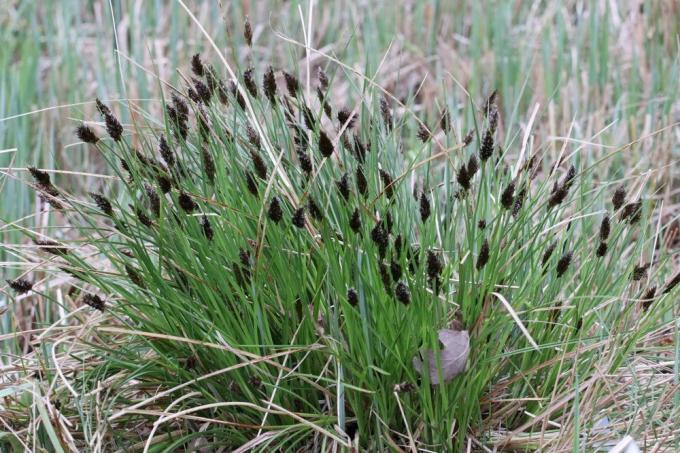
Fescue (festuca)
The robust fescue is one of the sweet grasses. They survive even colder winter days unscathed. Fescue can easily be recognized by their compact, bushy growth with very fine leaflets. Among the most popular of these evergreen grasses are those listed below.
- Blue fescue (Festuca cinerea): forms blue-gray clumps
- Bear fescue / bearskin grass (Festuca scoparia): deep green, dense hemispheres
- Golden fescue (Festuca glauca): golden yellow, fine stalks

Feather grass (stipa)
In the wild, feather grasses are unfortunately now threatened with extinction. As evergreen winter plants, they are in great demand simply because they are particularly drought-resistant.
- Angel hair (Stipa tenuissima)
- Tufted hair grass (Stipa capillata)
- Maidenhead grass (Stipa tenuifolia)

Evergreen dwarf shrubs
Wintergreen dwarf shrubs are suitable for increasing the height of the planting in the balcony box.
Japanese spindle bush (Euonymus japonicus)
The Japanese spindle bush grows upright and quite slowly. It is easy to care for and well tolerated by pruning, frost hardy and insensitive to heat. The spindle bush is not only one of the perfect winter plants, but is also suitable for summer planting in balcony boxes. When buying, look for a hardy variety like Euonymus japonicus, as there are also deciduous spindle bushes.
- yellow-green variegated leaves
- available in different sizes and types
- evergreen

Creeping spindle (Euonymus fortunei)
The creeper belongs to the same family as the Japanese spindle bush. It is also evergreen and grows very slowly - but not upright, but creeping. On the other hand, the crawler spindle is able to climb a few meters high, provided it is offered a climbing aid. The variegated foliage varieties are particularly beautiful:
- White-colored crawling spindle 'Emeralds Geiety': green-white variegated, small leaves
- Gold-colored crawling spindle 'Emeralds Gold': yellow-colored, evergreen leaves

Colorful winter plants
Usually it is the beautiful colors and shapes of the leaves that make a plant an attractive candidate for the winter window box. There are a number of balcony flowers that keep their beautiful foliage through winter.
Purple bells (Heuchera cultivare)
Although the purple bell is not a winter-flowering plant, its beauty is not shown in the abundance of flowers. The special thing about the herbaceous balcony flowers are their attractive leaves. The new, robust varieties tolerate both the sun and shady spots on the balcony.
- 'Key Lime Pie': fresh, lime green leaves
- 'Jam': maple-shaped leaf, ocher-colored above, dark-pink underside
- 'Green Spice': strong green leaves with dark purple veins
- 'Silver Lord': dark purple leaves, coated in silver
- 'Apple Crisp': strongly curled leaves with an apple-green color, slightly silver-coated
- 'Red Fury': bright sienna-colored leaves, slightly wavy on the edge
- 'Midnight Rose': very dark purple foliage with bright pink spots
- 'Electra': bright light green leaves with red veins
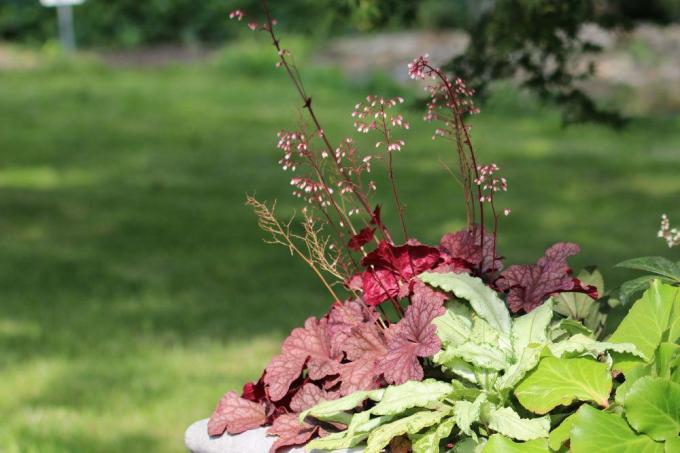
Spurge (Euphorbia cultivar Helena)
The hardy, evergreen perennial forms narrow rosettes of leaves with white stripes on the edge. At low temperatures, the shade of the balcony flowers changes and the foliage is tinged with pink. For this reason, the Euphorbia cultivar is particularly popular among winter plants for window boxes.
- variegated foliage
- slightly pink in frost
- young shoots are reddish in color
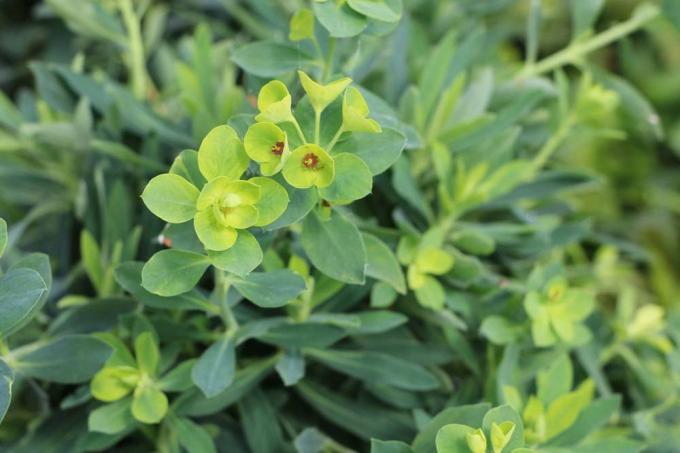
Creeping Gunsel (Ajuga reptans)
The creeping Günsel is not a winter-flowering plant, but flowers in spring, but it is still ideal for planting window boxes over the winter. The easy-care ground cover is winter or evergreen depending on the variety and impresses with shiny metallic leaves.
- Foliage in green, brown or red
- grows very densely and partly overhanging
- needs moist soil in sunny locations
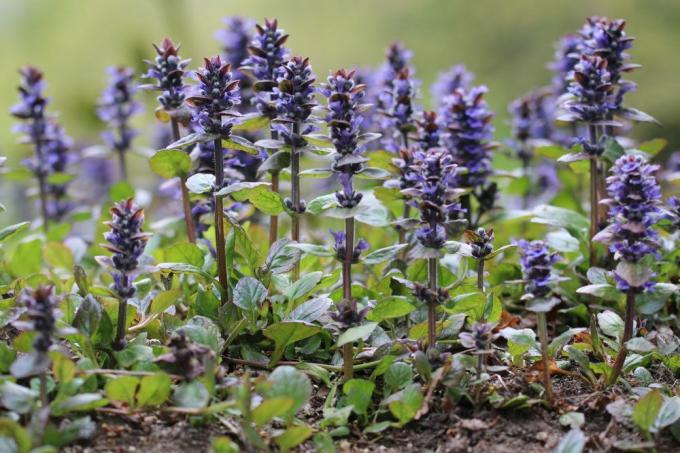
Silver wire plant (Calocephalus brownii)
This small, silver-colored shrub is somewhat reminiscent of barbed wire. In the balcony box, the typical winter plants keep their color throughout the winter.
- not hardy
- however, retains color and shape when dead
- perfect for combinations with heather plants, skimmias and pseudo berries

Ivy (Hedera helix)
In addition to blooming winter plants in the balcony box, a few hanging specimens should of course not be missing. The evergreen ivy is perfect for this purpose. You can buy ivy with a wide variety of leaf shapes and colors, so that you can find the right variant for every arrangement.
- 'Yellow Ripple': slightly elongated leaves with a green center and a creamy yellow edge
- 'Sagittifolia' (arrow-leaved ivy): dark green leaves, very deeply incised
- 'White Wonder': medium green leaves with a white border
- 'Tear Drop': teardrop-shaped, green leaves
- 'Mini': variant with tiny, dark green leaves
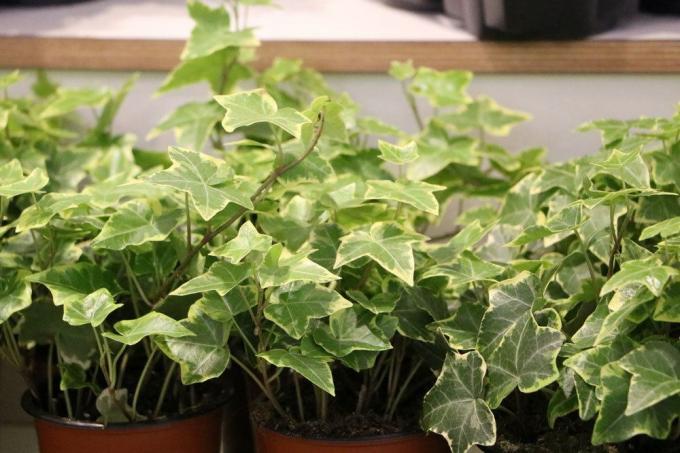
Winter plants with colorful berries
Gaultheria procumbens (Gaultheria procumbens)
Beautifully colored foliage in winter, attractive red berries - hardly any other plant tries so hard to attract attention in the dark season as the pseudo-berry. The oval, small leaves are usually simply green over the summer, but turn a deep red or purple in autumn. And the fruits are also exceptional. They are red, pink or white and stay on the shrubby plant until spring.
- evergreen
- beautiful autumn and winter colors of the leaves
- attractive berries

Japanese flower skimmia (Skimmia japonica)
Skimmia are beautiful to look at all year round. Its fragrant white or red flowers open in spring and the foliage stays on the plant even in the cold season. In autumn the Skimmias produce red globular fruits every year.
- Blossoms (small red globules) already form in autumn
- Flowers open in spring
- spherical, pea-sized berries in bright red

Nice combinations
So that the roots of the winter flowers do not freeze completely, the flower box must not be too small. We recommend dimensions of at least 60 x 30 x 30 cm. A drainage layer on the floor prevents the formation of waterlogging. The number of balcony flowers depends of course on the size of the balcony box.
Variant 1 (about 60 cm wide)
- Heather
- Sedge (Carex hachijoensis 'Evergold')
- Silver leaf / white felted ragwort (Senecio cineraria)
- Japanese spindle bush (Euonymus japonicus)
- Purple bells (Heuchera cultivare 'Red Fury')
- Common heather (Calluna vulgaris 'Skyline')
- Günsel (Ajuga reptans 'Elmblut')
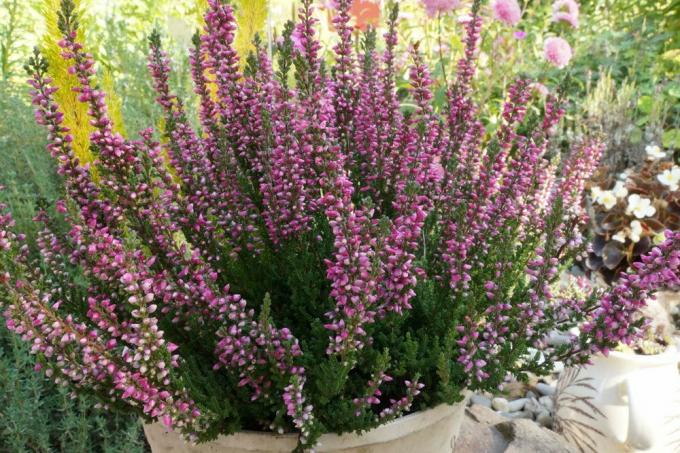
Variant 2 (small box about 40 cm wide)
- Sedge (Carex morrowii 'Ice Dance')
- Purple bells (Heuchera cultivare 'Midnight Rose')
- Japanese spindle bush (Euonymus japonicus)
Variant 3 (box width 40 - 50 cm)
- Common heather, heather multicolored
- Purple bells (Heuchera cultivare 'Red Fury')
- Sedge (Carex morrowii 'Ice Dance')
- Ivy (Hedera helix 'White Wonder')
Variant 4 (60 - 80 cm width)
- Purple bells (Heuchera triarelloides 'Stoplight')
- Heather / common heather (Calluna vulgaris, red)
- Ivy (Hedera helix 'White Wonder')
- Japanese spindle (Euonymus japonicas)
- Spurge (Euphorbia cultivar 'Helena')
- Blue fescue ornamental grass (Festuca glauca 'Eisvogel')
Variant 5 (60 to 80 cm box width)
- Purple bells (Heuchera cultivare 'Silver Gold')
- Common heather (Calluna vulgaris, red)
- Common heather (Calluna vulgaris, white)
- Ivy (Hedera helix 'Wonder')
- Japanese spindle bush (Eonymus japonicus 'Aureomarginatus') variegated
- Red Carpet Berry (Gaulheria procumbens)



